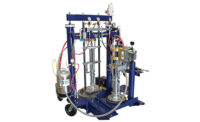When selecting a two-component dispense valve for your meter, mix, and dispense applications, there are many factors to consider before the correct valve can be selected.
Chemicals
It is essential to know the attributes of the materials you will be dispensing, obtained from the manufacturers Material Safety Data Sheet (MSDS). Today there are many epoxies, silicones, urethanes, methacrylics and other adhesive and sealants with a wide variety of physical properties. With so many different material chemistries available, consideration needs be given to the components of the valve that will come in contact with the material.
Viscosity
When dispensing two-component materials with different viscosities, it is critical that both materials come together in the mixer at the same time, on ratio and at the correct flow rate. If this does not happen there is a possibility the mixed material will not cure, leaving an uncured “soft spot” in the encapsulant or a place where the material does not adhere, resulting in failed or scrapped parts and loss of production. The lower viscosity material will flow more readily and with less back pressure than the thicker material. It is therefore important to design the dispense valve so the thinner material does not come out of the valve sooner that the thicker material. This condition is called “Lead-Lag”. To resolve this difference, forethought must be given to the sizing of the valve exit ports, so the back pressure and flow rates of the two materials allow proper flow and a uniform, homogenous mix. If the problem cannot be resolved, a dual valve static mix manifold could be used.
Viscosity can also influence how the material stops flowing when the dispense valve is shut off. Ideally you want the flow of material to stop clean once the valve is turned off. This prevents wasted material, having the mixed material string or ooze on the outside of the parts. Thinner materials that seek their own level need to be dispensed from a No-Drip, ball & seat style dispense valve. This style of valve shifts the ball onto the seat, impeding the flow of the material. Thicker materials that cause greater back pressure in the mixing chamber and can be stringy and difficult to shut off cleanly from the mixer require a Snuf-Bak, spool style valve. The Snuf-Bak valve draws a spool back to shut off. This action eliminates the pressure in the mixer that would bleed out if it is not reduced.
Ratio
Material ratios can vary from 1:1 (1 part resin mixed with 1 part catalyst) to beyond 100:1. Not all valves are designed to dispense ratios greater than 5:1, so it’s important to know the volumetric ratio of the material you will be dispensing and ensure the valve is capable of operating at that ratio. Wider ratio materials present more challenging conditions, not only does the dispense valve have to be designed to compensate for the difference in flow rate and the back pressure, but the metering equipment has to be capable of maintaining the correct ratio at the necessary flow rate(s), to the dispense valve.
Flow Rates
The flow rate of your process dictates the size of the dispense valve you choose. It’s important to make certain the valve is capable of providing the mixed material at the volume needed for your process. If the sizing on the valve is too small, the back pressure can have an adverse effect on the metering equipment and could possibly influence the performance and ratio of your equipment.
Dispense valve selection for a two-component dispensing application can seem somewhat overwhelming, but by having all your material and process information available you will simplify the selection when you consult a valve expert. This will leave you with fewer worries and ultimately a dispense valve configured to your specific application.
For more information:
http://www.nordson.com/en/divisions/sealant-equipment/resources/valve-selection-guide
Nordson Corporation
45677 Helm Street
Plymouth, MI 48170
+1.734.459.8600 Phone
www.SealantEquipment.com/ValveGuide








